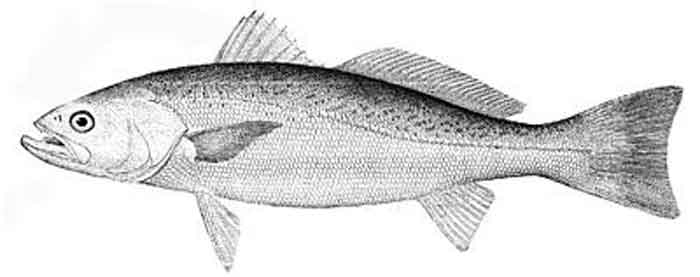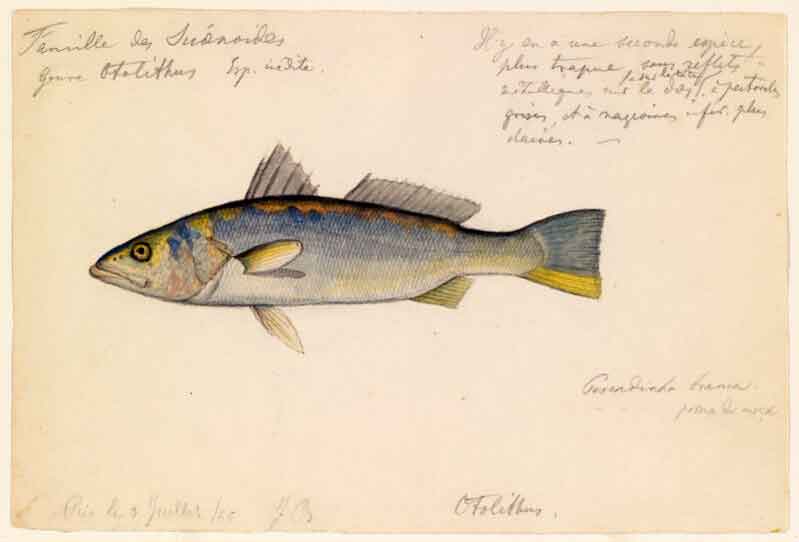Superregnum: Eukaryota
Cladus: Unikonta
Cladus: Opisthokonta
Cladus: Holozoa
Regnum: Animalia
Subregnum: Eumetazoa
Cladus: Bilateria
Cladus: Nephrozoa
Superphylum: Deuterostomia
Phylum: Chordata
Subphylum: Vertebrata
Infraphylum: Gnathostomata
Megaclassis: Osteichthyes
Superclassis/Classis: Actinopterygii
Classis/Subclassis: Actinopteri
Subclassis/Infraclassis: Neopterygii
Infraclassis: Teleostei
Megacohors: Osteoglossocephalai
Supercohors: Clupeocephala
Cohors: Euteleosteomorpha
Subcohors: Neoteleostei
Infracohors: Eurypterygia
Sectio: Ctenosquamata
Subsectio: Acanthomorphata
Divisio/Superordo: Acanthopterygii
Subdivisio: Percomorphaceae
Series: Eupercaria
Ordo: Perciformes
Subordo: Percoidei
Superfamilia: Percoidea
Familia: Sciaenidae
Genus: Cynoscion
Species: C. acoupa – C. albus – C. analis – C. arenarius – C. guatucupa – C. jamaicensis – †C. latiostialis – C. leiarchus – C. microlepidotus – C. nannus – C. nebulosus – C. nortoni – C. nothus – C. othonopterus – C. parvipinnis – C. phoxocephalus – C. praedatorius – †C. prolixus – C. regalis – C. reticulatus – †C. scitulus – C. similis – C. squamipinnis – C. steindachneri – C. stolzmanni – C. striatus – C. virescens – C. xanthulus
Name
Cynoscion Gill, 1861

Cynoscion regalis
References
Santos, S., Gomes, M. d. F., Soares Ferreira, A. R., Sampaio, I. & Schneider, H.; 2012: Molecular phylogeny of the western South Atlantic Sciaenidae based on mitochondrial and nuclear data. Molecular Phylogenetics and Evolution, Available online 4 October 2012, In Press, Accepted Manuscript, abstract
Cynoscion – Taxon details on Integrated Taxonomic Information System (ITIS).
Cynoscion species list in FishBase,
Froese, R. & Pauly, D. (eds.) 2024. FishBase. World Wide Web electronic publication, www.fishbase.org, version 02/2024.
Vernacular names
English: Sea trouts, Weakfishes

Cynoscion leiarchus
Cynoscion is a genus of marine ray-finned fishes belonging to the family, Sciaenidae, the drums and croakers. These fishes are found off the coasts of North and South America in the western Atlantic and eastern Pacific Oceans. Many fishes in this genus have been given the common name weakfish.
Taxonomy
Cynoscion was first proposed as a monospecific genus in 1861 by the American biologist Theodore Gill with Johnnius regalis, a species originally described in 1801 from New York by Marcis Elieser Bloch and Johann G. T. Schneider, designated as its type species.[1][2] This genus has been placed in the subfamily Cynoscioninae by some workers,[3] but the 5th edition of Fishes of the World does not recognise subfamilies within the Sciaenidae which it places in the order Acanthuriformes.[4]
Etymology
Cynoscion is a combination of cyno, meaning "dog", a reference to the pair of canine-like teeth in the upper jaw, with scion, the modern Greek name of Umbrina cirrosa, which Gill preferred over sciaena because he did not like the sound of Cynosciaena.[5] The common name, weakfish, is a reference to the easily torn membrane in the mouth of C. regalis.[6]
Species
The genus consists of 25 species:[7]
Cynoscion acoupa (Lacépède, 1801) (Acoupa weakfish)
Cynoscion albus (Günther, 1864) (Whitefin weakfish)
Cynoscion analis (Jenyns, 1842) (Peruvian weakfish)
Cynoscion arenarius (Ginsburg, 1930) (Sand seatrout)
Cynoscion guatucupa (Cuvier, 1830) (Stripped weakfish)
Cynoscion jamaicensis (Vaillant and Bocourt, 1883) (Jamaica weakfish)
Cynoscion leiarchus (Cuvier, 1830) (Smooth weakfish)
Cynoscion microlepidotus (Cuvier, 1830) (Smallscale weakfish)
Cynoscion nannus (Castro-Aguirre & Arvizu-Martinez, 1976) (Dwarf weakfish)
Cynoscion nebulosus (Cuvier, 1830) (Spotted seatrout)
Cynoscion nortoni (Béarez, 2001) (Hake weakfish)
Cynoscion nothus (Holbrook, 1848) (Silver seatrout)
Cynoscion othonopterus (Jordan and Gilbert, 1882) (Gulf weakfish)
Cynoscion parvipinnis (Ayres, 1861) (Shortfin corvina)
Cynoscion phoxocephalus (Jordan and Gilbert, 1882) (Cachema weakfish)
Cynoscion praedatorius (Jordan and Gilbert, 1889) (Boccone weakfish)
Cynoscion regalis (Bloch and Schneider, 1801)(Squeteague)
Cynoscion reticulatus (Günther, 1864)
Cynoscion similis (Randall and Cervigón, 1968) (Tonkin weakfish)
Cynoscion squamipinnis (Günther, 1867) (Scalyfin corvina)
Cynoscion steindachneri (Jordan, 1889) (Smalltooth weakfish)
Cynoscion stolzmanni (Steindachner, 1879) (Yellowtail corvina)
Cynoscion striatus (Cuvier, 1829) (Striped weakfish)
Cynoscion virescens (Cuvier, 1830) (Green weakfish)
Cynoscion xanthulus Jordan & Gilbert, 1882 (Orangemouth weakfish)
FishBase treats C. striatus as a valid species[7] but the Catalog of Fishes states that this is a nomen oblitum and is in the synonymy of C. guatucupa.[2]
Characteristics
Cynoscion weakfishes have an elongate, torpedo shapes body which is compressed to give it an oval cross-section. The head is low, with the crown being firm to the touch rather than spongy with moderately sized eyes and a large oblique mouth. There is a pair of large, pointed canine-like teeth in the front of the upper jaw. There are no barbels or pores on the chin. The preoperculum is smooth and not serrated and the top corner of gill slit is incised. The dorsal fin is long based and is deeply incised with between 7 and 9 thin spines and between 20 and 30 soft rays. The anal fin is supported by 2 small spines, less than half the length of the first anal fin ray, and 7 to 13 soft rays. They have large scales, ctenoid on the body and cycloid on the head. The lateral line reaches to the middle of the end of the caudal fin.[8] The largest species in the genus are C. albus which has a maximum published total length of 130 cm (51 in) and C. xanthulus at 129 cm (51 in) while the smallest is C. nannus reaching 27 cm (11 in).[7]
Distribution
Cynoscion weakfishes are found off the Americas in the eastern Pacific and western Atlantic Oceans being found in tropical and warm temperate waters.[8]
References
Eschmeyer, William N.; Fricke, Ron & van der Laan, Richard (eds.). "Genera in the family Sciaenidae". Catalog of Fishes. California Academy of Sciences. Retrieved 30 April 2023.
Eschmeyer, William N.; Fricke, Ron & van der Laan, Richard (eds.). "Species in the genus Cynoscion". Catalog of Fishes. California Academy of Sciences. Retrieved 30 April 2023.
Kunio Sasaki (1989). "Phylogeny of the family Sciaenidae, with notes on its Zoogeography (Teleostei, Peciformes)" (PDF). Memoirs of the Faculty of Fishes Hokkaido University. 36 (1–2): 1–137.
J. S. Nelson; T. C. Grande; M. V. H. Wilson (2016). Fishes of the World (5th ed.). Wiley. pp. 497–502. ISBN 978-1-118-34233-6. Archived from the original on 2019-04-08. Retrieved 2023-04-30.
Christopher Scharpf & Kenneth J. Lazara, eds. (9 March 2023). "Series Eupercaria (Incertae sedis): Families Callanthidae, Centrogenyidae, Dinopercidae, Emmelichthyidae, Malacanthidae, Monodactylidae, Moronidae, Parascorpididae, Sciaenidae and Sillagidae". The ETYFish Project Fish Name Etymology Database. Christopher Scharpf and Kenneth J. Lazara. Retrieved 26 April 2023.
"Weakfish". Delaware Department of Natural Resources and Environmental Control. Retrieved 1 May 2023.
Froese, Rainer and Pauly, Daniel, eds. (2023). Species of Cynoscion in FishBase. February 2023 version.
"Genus: Cynoscion, Weakfish Croaker, Weakfishes". Shorefishes of the Greater Caribbean online information system. Smithsonian Tropical Research Institute. Retrieved 30 April 2023.
Retrieved from "http://en.wikipedia.org/"
All text is available under the terms of the GNU Free Documentation License

